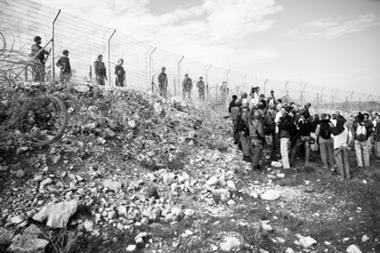
The Council on Foreign Relations, a US foreign policy think tank, released a report on the most likely conflicts next year that the US government should focus its attention on.
The CFR asked government officials, academics and risk experts to rank a group of possible conflicts into three tiers of relative risk to US national interests (see the maps below).
Tier 1

Tier I are contingencies that directly threaten the US homeland and are likely to trigger US military involvement because they threaten vital national interests or critical resources. These include
| These include: |
| a mass casualty attack on the U.S. homeland or on a treaty ally |
|---|
| a severe North Korean crisis (e.g., armed provocations, internal political instability, advances in nuclear weapons/ICBM capability) |
| a major military incident with China involving U.S. or allied forces |
| an Iranian nuclear crisis (e.g., surprise advances in nuclear weapons/delivery capability, Israeli response) |
| a highly disruptive cyberattack on U.S. critical infrastructure (e.g., telecommunications, electrical power, gas and oil, water supply, banking and finance, transportation, and emergency services) |
| a significant increase in drug trafficking violence in Mexico that spills over into the United States |
| severe internal instability in Pakistan, triggered by a civil-military crisis or terror attacks |
| political instability in Saudi Arabia that endangers global oil supplies |
| a U.S.-Pakistan military confrontation, triggered by a terror attack or U.S. counterterror operations |
| intensification of the European sovereign debt crisis that leads to the collapse of the euro, triggering a double-dip U.S. recession and further limiting budgetary resources |
Tier 2

Tier II are contingencies that affect countries of strategic importance to the US but that do not involve a mutual-defense treaty commitment. These include:
| These include: |
| political instability in Egypt with wider regional implications |
|---|
| a severe Indo-Pak crisis that carries risk of military escalation, triggered by major terror attack |
| a severe Indo-Pak crisis that carries risk of military escalation, triggered by major terror attack |
| rising tension/naval incident in the eastern Mediterranean Sea between Turkey and Israel |
| a major erosion of security and governance gains in Afghanistan with intensification of insurgency or terror attacks |
| an outbreak of widespread civil violence in Syria, with potential outside intervention |
| an outbreak of widespread civil violence in Yemen |
| rising sectarian tensions and renewed violence in Iraq |
| a mass casualty attack on Israel |
| growing instability in Bahrain that spurs further Saudi and/or Iranian military action |
Tier 3

Tier III are contingencies that could have severe or widespread humanitarian consequences but in countries of limited strategic importance to the US. These include:
| These include: |
| military conflict between Sudan and South Sudan |
|---|
| heightened political instability and sectarian violence in Nigeria |
| increased conflict in Somalia, with continued outside intervention |
| political instability in Venezuela surrounding the October 2012 elections or post-Chavez succession |
| political instability in Kenya surrounding the August 2012 elections |
| renewed military conflict between Russia and Georgia |
| an intensification of political instability and violence in Libya |
| violent election-related instability in the Democratic Republic of the Congo |
| political instability/resurgent ethnic violence in Kyrgyzstan |
| an outbreak of military conflict between Armenia and Azerbaijan, possibly over Nagorno Karabakh |
The Center for Preventive Action is solely responsible for this survey and its results. The survey is made possible by the generous support of the Carnegie Corporation of New York.




















No comments yet